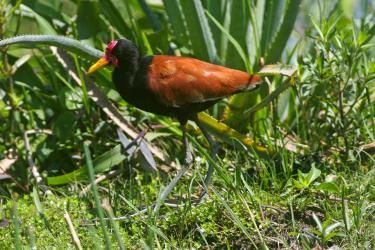Le Jacana noir (Jacana jacana) est une espèce d'oiseaux limicoles de la famille des Jacanidae.
Description
Le Jacana noir est un petit oiseau de 17 à 25 centimètres de longueur avec de longues pattes gris doré aux doigts mesurant quatre centimètres. Les doigts lui permettent de répartir le poids de son corps de façon à pouvoir se promener sur la végétation aquatique. Il pèse en moyenne de 90 à 125 grammes, mais la femelle, beaucoup plus grande que le mâle, arrive même à peser 150 grammes.
Généralement, il est noir avec le dos châtain, quand il est en vol on remarque vite la couleur jaune des rémiges (la sous-espèce Jacana jacana scapularis a le plumage entièrement noir). Le bec est jaune, et on remarque à sa base des barbillons rouges. Sur le bord antérieur des ailes ressort un petit éperon, typique de l'espèce. il a un bec crochu coloré de jaune.
Alimentation
En se promenant sur l'eau, le jacana se procure la nourriture nécessaire à sa subsistance. Il chasse surtout des insectes et d'autres petits invertébrés, mais prélève aussi les grains de riz qui flottent sur la surface.
Distribution
Ce jacana est l'unique représentant de ce groupe en Amérique du Sud, du Panama à l'Argentine. En particulier Jacana jacana hypomelaena qui vit au Panama et en Colombie ; Jacana jacana scapularis en Équateur ; Jacana jacana peruviana au Pérou et au Chili ; Jacana jacana jacana, la sous-espèce la plus nombreuse, qui vit au Brésil et dans le nord du continent.
Reproduction
Chez cette espèce, ce sont les femelles, plus grandes que les mâles, qui combattent pour pouvoir s'accoupler. Les combats sont violents : les éperons sur les ailes infligent quelquefois de graves blessures. Lorsqu'une femelle gagne le combat, elle a la possibilité de s'accoupler avec plusieurs mâles (jusqu'à trois).
Chaque mâle construit ensuite un nid flottant, couve les œufs qui sont en général quatre, bruns tachés de noir, et élève les petits jusqu'au sevrage. Entretemps, la femelle défend le territoire des possibles intrus. Les poussins sont complètement blancs dans la partie inférieure du corps et brun grisâtre dans la supérieure.
Taxinomie
D'après Alan P. Peterson, cette espèce est constituée des six sous-espèces suivantes :



